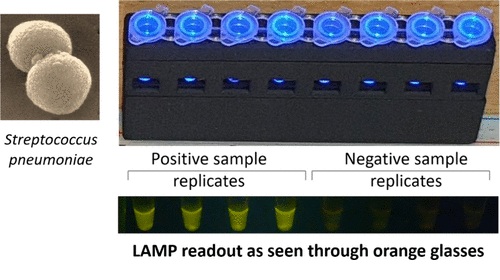Circadian Rhythm Genes Are Biomarkers for Predicting Risk of Preterm Birth
|
By LabMedica International staff writers Posted on 17 Aug 2021 |

Structure of CLOCK circadian regulator (courtesy of: Wikimedia Commons)
The CLOCK and CRY2 genes have been identified as useful biomarkers for predicting the likelihood that a pregnant woman will experience a preterm birth.
Previous studies have observed an association between maternal circadian rhythm disruption and preterm birth. However, the underlying molecular mechanisms and the potential of circadian clock genes to serve as predictors of preterm birth remain unexplored.
Investigators at Michigan State University (East Lansing, USA) examined the association of 10 core circadian transcripts in maternal blood with spontaneous preterm births versus full term births using a nested case-control study design. For this study, maternal blood was sampled in trimesters two-three from women with spontaneous preterm births (n = 51) and full term births (n = 106), matched for five demographic variables.
Results revealed that in second trimester maternal blood, only CLOCK and CRY2 transcripts were significantly lower in spontaneous preterm births versus full term. In addition, the investigators identified 98 common pathways that were negatively or positively correlated with CLOCK and CRY2 expression.
CLOCK is a gene encoding a basic helix-loop-helix-PAS transcription factor that is believed to affect both the persistence and period of circadian rhythms. The CLOCK gene plays a major role as an activator of downstream elements in the pathway critical to the generation of circadian rhythms. In mammals, the proteins coded by the CRY1 and CRY2 genes act as light-independent inhibitors of CLOCK-BMAL1 components of the circadian clock.
“We were excited to discover lower mRNA levels in the CRY2 and CLOCK genes,” said senior author Dr. Hanne Hoffmann, assistant professor of animal science at Michigan State University. “Preterm births are common. If we know the mother is at risk for a preterm birth, her doctor can monitor her more closely. If we could measure women’s mRNA levels and tell them for their second or third pregnancies that they are not at risk for a preterm birth because their levels are higher (in a normal/healthy range), that would be such a comfort to the mothers who previously had a preterm birth. If I can help one baby make it to full term who was not supposed to, that would make my day.”
The preterm birth study was published in the June 18, 2021, online edition of the Journal Biology of Reproduction.
Related Links:
Michigan State University
Previous studies have observed an association between maternal circadian rhythm disruption and preterm birth. However, the underlying molecular mechanisms and the potential of circadian clock genes to serve as predictors of preterm birth remain unexplored.
Investigators at Michigan State University (East Lansing, USA) examined the association of 10 core circadian transcripts in maternal blood with spontaneous preterm births versus full term births using a nested case-control study design. For this study, maternal blood was sampled in trimesters two-three from women with spontaneous preterm births (n = 51) and full term births (n = 106), matched for five demographic variables.
Results revealed that in second trimester maternal blood, only CLOCK and CRY2 transcripts were significantly lower in spontaneous preterm births versus full term. In addition, the investigators identified 98 common pathways that were negatively or positively correlated with CLOCK and CRY2 expression.
CLOCK is a gene encoding a basic helix-loop-helix-PAS transcription factor that is believed to affect both the persistence and period of circadian rhythms. The CLOCK gene plays a major role as an activator of downstream elements in the pathway critical to the generation of circadian rhythms. In mammals, the proteins coded by the CRY1 and CRY2 genes act as light-independent inhibitors of CLOCK-BMAL1 components of the circadian clock.
“We were excited to discover lower mRNA levels in the CRY2 and CLOCK genes,” said senior author Dr. Hanne Hoffmann, assistant professor of animal science at Michigan State University. “Preterm births are common. If we know the mother is at risk for a preterm birth, her doctor can monitor her more closely. If we could measure women’s mRNA levels and tell them for their second or third pregnancies that they are not at risk for a preterm birth because their levels are higher (in a normal/healthy range), that would be such a comfort to the mothers who previously had a preterm birth. If I can help one baby make it to full term who was not supposed to, that would make my day.”
The preterm birth study was published in the June 18, 2021, online edition of the Journal Biology of Reproduction.
Related Links:
Michigan State University
Latest Microbiology News
- High-Throughput Enteric Panels Detect Multiple GI Bacterial Infections from Single Stool Swab Sample
- Fast Noninvasive Bedside Test Uses Sugar Fingerprint to Detect Fungal Infections
- Rapid Sepsis Diagnostic Device to Enable Personalized Critical Care for ICU Patients
- Microfluidic Platform Assesses Neutrophil Function in Sepsis Patients
- New Diagnostic Method Confirms Sepsis Infections Earlier
- New Markers Could Predict Risk of Severe Chlamydia Infection
- Portable Spectroscopy Rapidly and Noninvasively Detects Bacterial Species in Vaginal Fluid
- CRISPR-Based Saliva Test Detects Tuberculosis Directly from Sputum
- Urine-Based Assay Diagnoses Common Lung Infection in Immunocompromised People
- Saliva Test Detects Implant-Related Microbial Risks
- New Platform Leverages AI and Quantum Computing to Predict Salmonella Antimicrobial Resistance
- Early Detection of Gut Microbiota Metabolite Linked to Atherosclerosis Could Revolutionize Diagnosis
- Viral Load Tests Can Help Predict Mpox Severity
- Gut Microbiota Analysis Enables Early and Non-Invasive Detection of Gestational Diabetes
- Credit Card-Sized Test Boosts TB Detection in HIV Hotspots
- Fecal Metabolite Profiling Predicts Mortality in Critically Ill Patients
Channels
Clinical Chemistry
view channel
VOCs Show Promise for Early Multi-Cancer Detection
Early cancer detection is critical to improving survival rates, but most current screening methods focus on individual cancer types and often involve invasive procedures. This makes it difficult to identify... Read more
Portable Raman Spectroscopy Offers Cost-Effective Kidney Disease Diagnosis at POC
Kidney disease is typically diagnosed through blood or urine tests, often when patients present with symptoms such as blood in urine, shortness of breath, or weight loss. While these tests are common,... Read moreMolecular Diagnostics
view channel
New Diagnostic Method Detects Pneumonia at POC in Low-Resource Settings
Pneumonia continues to be one of the leading causes of death in low- and middle-income countries, where limited access to advanced laboratory infrastructure hampers early and accurate diagnosis.... Read more
Blood Immune Cell Analysis Detects Parkinson’s Before Symptoms Appear
Early diagnosis of Parkinson’s disease remains one of the greatest challenges in neurology. The condition, which affects nearly 12 million people globally, is typically identified only after significant... Read moreHematology
view channel
ADLM’s New Coagulation Testing Guidance to Improve Care for Patients on Blood Thinners
Direct oral anticoagulants (DOACs) are one of the most common types of blood thinners. Patients take them to prevent a host of complications that could arise from blood clotting, including stroke, deep... Read more
Viscoelastic Testing Could Improve Treatment of Maternal Hemorrhage
Postpartum hemorrhage, severe bleeding after childbirth, remains one of the leading causes of maternal mortality worldwide, yet many of these deaths are preventable. Standard care can be hindered by delays... Read more
Pioneering Model Measures Radiation Exposure in Blood for Precise Cancer Treatments
Scientists have long focused on protecting organs near tumors during radiotherapy, but blood — a vital, circulating tissue — has largely been excluded from dose calculations. Each blood cell passing through... Read moreImmunology
view channel
Blood-Based Liquid Biopsy Model Analyzes Immunotherapy Effectiveness
Immunotherapy has revolutionized cancer care by harnessing the immune system to fight tumors, yet predicting who will benefit remains a major challenge. Many patients undergo costly and taxing treatment... Read more
Signature Genes Predict T-Cell Expansion in Cancer Immunotherapy
Modern cancer immunotherapies rely on the ability of CD8⁺ T cells to rapidly multiply within tumors, generating the immune force needed to eliminate cancer cells. However, the biological triggers behind... Read morePathology
view channel
New Molecular Analysis Tool to Improve Disease Diagnosis
Accurately distinguishing between similar biomolecules such as proteins is vital for biomedical research and diagnostics, yet existing analytical tools often fail to detect subtle structural or compositional... Read more
Tears Offer Noninvasive Alternative for Diagnosing Neurodegenerative Diseases
Diagnosing and monitoring eye and neurodegenerative diseases often requires invasive procedures to access ocular fluids. Ocular fluids like aqueous humor and vitreous humor contain valuable molecular information... Read moreTechnology
view channel
Cell-Sorting Device Uses Electromagnetic Levitation to Precisely Direct Cell Movement
Sorting different cell types—such as cancerous versus healthy or live versus dead cells—is a critical task in biology and medicine. However, conventional methods often require labeling, chemical exposure,... Read more
Embedded GPU Platform Enables Rapid Blood Profiling for POC Diagnostics
Blood tests remain a cornerstone of medical diagnostics, but traditional imaging and analysis methods can be slow, costly, and reliant on dyes or contrast agents. Now, scientists have developed a real-time,... Read moreIndustry
view channel
Qiagen Acquires Single-Cell Omics Firm Parse Biosciences
QIAGEN (Venlo, Netherlands) has entered into a definitive agreement to fully acquire Parse Biosciences (Seattle, WA, USA), a provider of scalable, instrument-free solutions for single-cell research.... Read more
Puritan Medical Products Showcasing Innovation at AMP2025 in Boston
Puritan Medical Products (Guilford, ME, USA), the world’s most trusted manufacturer of swabs and specimen collection devices, is set to exhibit at AMP2025 in Boston, Massachusetts, from November 11–15.... Read more
Advanced Instruments Merged Under Nova Biomedical Name
Advanced Instruments (Norwood, MA, USA) and Nova Biomedical (Waltham, MA, USA) are now officially doing business under a single, unified brand. This transformation is expected to deliver greater value... Read more




 assay.jpg)




 Analyzer.jpg)












